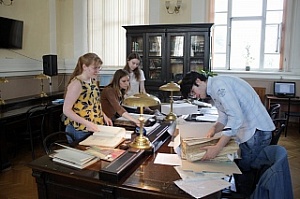The TSU Research Library has completed the archeographic internship of students from the Faculty of Historical and Political Studies. Under the guidance of Professor Elena Dutchak, freshmen mastered methods of historical-documentary examination of old printed books and publications of illegal Old Believer printing houses, and studied not only the original printed publications but also their digital analogs.
This archaeographic internship was part of a joint study of the Research Library and the Laboratory of Library and Communicative Research, which is dedicated to the monasterial library - the book collection of an Old Believer taiga monastery, which includes 250 monuments of manuscript and printed confessional literature of the late 15th to early 21st centuries.
Digital copies of Old Russian and Old Believer manuscripts with English and Russian commentaries are available on the website of the international program Endangered Archives and in the Electronic Library (repository) of Tomsk State University. The print part of this unique collection is currently being prepared for digitization.
- The full availability of the monasterial library is of great importance, - said Elena Dutchak, head of the Laboratory for Library and Communicative Research. - Presentation of its ancient and new, printed and manuscript texts as a single information complex shows the processes and results of mastering the culture of Cyrillic writing and reading by Siberian Old Believers.
According to Professor Dutchak, the question “under what conditions can a digital analog of a rare collection become a platform for solving systemically connected scientific, educational, and enlightening tasks?” is especially important. In the laboratory project “The Model of Open Science in Russian Universities: Risks and Opportunities”, it is solved taking into account the views of a new generation of researchers of Old Believer book collections – historian-students.
- Working with the books of the monasterial library is a unique experience in my life,- says first-year student Yekaterina Proskoryakova. - For the first time, I held in my hands and explored these historical sources of scientific value. I learned to look for information to compile an archaeographic description of an old-printed and Old Believer publication, to interpret and critically analyze it. My main find was a handwritten travel diary, the author of which was sent to the Old Believer monastery in April 1993. Perhaps this is a modern version of “Travelers” – the descriptions of routes to the legendary Belovodye, which existed among the peasants in the late 18th to early 20th centuries.
According to interns Anna Manannikova and Ivan Chertov, the restoration, based on indirect signs of the history of the creation and existence of the book, makes the study of an old book similar to a detective investigation.
Student Anna Ryazantseva is sure that work with old-printed and manuscript materials is now as relevant as ever:
- The ability to digitize almost any book monument that a historian has to deal with reveals previously unknown problems. Today it’s not enough to post text on the Internet, so maintaining digital copies with detailed scientific commentaries is a task of paramount importance. This will help the researcher to navigate the ever-growing information flow and will make it possible to show the public the secrets of old-printed and manuscript material.



